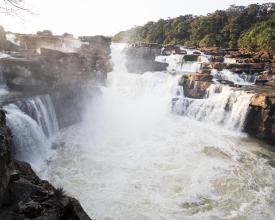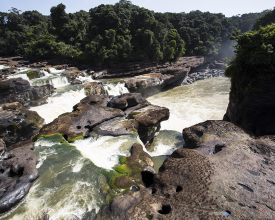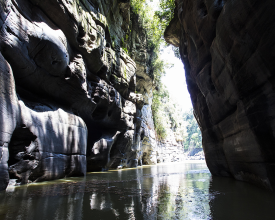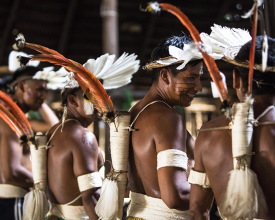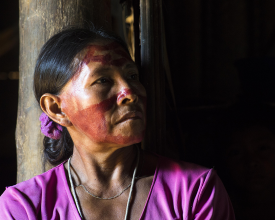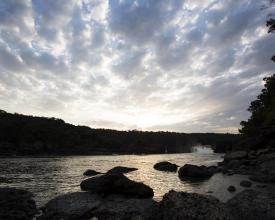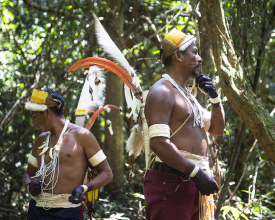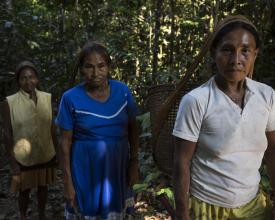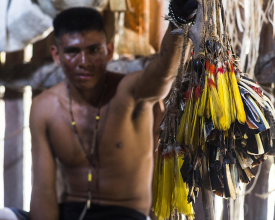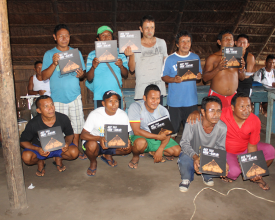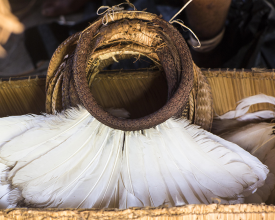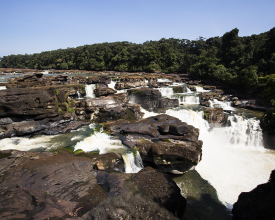
Creation and planning of the Yaigojé Apaporis Indigenous Reserve and Natural National Park from an indigenous cosmovision
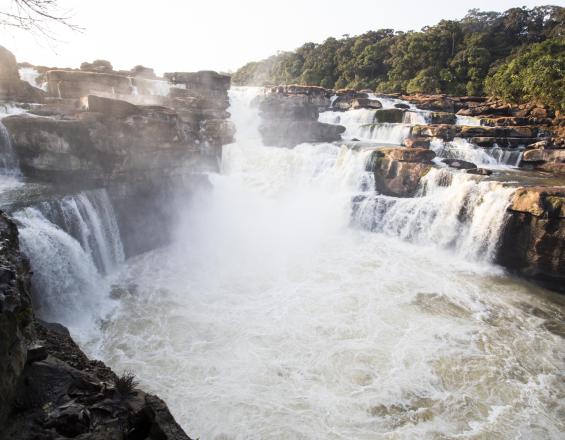
Seven indigenous peoples make up the Yaigojé Apaporis Indigenous Reserve in an area of great cultural diversity in the Colombian Amazon. Due to the fact that mining activities jeopardize its complex of sacred sites, the Indigenous Traditional Authorities requested the Colombian National Natural Parks (PNNC) to create a protected area overlapping the Reserve. In this contexts, the GAIA Amazonas Foundation developed a methodology for the indigenous communities themselves to manage the creation, planning, and zoning of the Yaigojé Apaporis Indigenous Reserve and Natural National Park.
Context
Challenges addressed
The seven indigenous peoples that comprise the Yaigojé Apaporis area form a unified cultural cluster that shares various elements, such as the traditional rituals performed in a complex of sacred sites. However, the external pressure of mining operations in their indigenous territory threatens their sacred sites, their natural environment, and culture. Seeing their limitations in facing these threats, the communities recognized the need of asking the support of the PNNC to protect their territory through the creation of a National Protected Area, which is a legal framework that guarantees the exclusion of sector development activities, in their particular case: mining operations. This initiative presented several challenges. Among them, being able to maintain their cultural values and indigenous cosmovision, promoting the use of traditional shamanic knowledge of their communities in the planning and zoning processes, and building mechanisms for participation and local dialog.
Location
Process
Summary of the process
The creation of the protected area by indigenous request and with the support of the National Government was achieved in the context of a process of free and informed previous consultation, and the establishment of special management agreements between the Government and the indigenous authorities, for the area's governance. Two key factors ensure that the planning process was founded on the indigenous cosmovision. First, the existence of the Special Management Regime (REM), which is a legal framework that maintains the inalienability of indigenous territories when they are categorized as a Natural National Park. Second, the formal acknowledgment of their cultural values in the Park’s creation objectives. To this end, the GAIA Amazonas Foundation led the development of a proper and adequate methodology that became a fundamental input for the indigenous organizations (as public authorities) together with the PNNC (as the environmental authority) to set the guidelines and build the REM according to the cultural and environmental features of Yaigojé Apaporis Reserve.
Building Blocks
Local social organization and national governmental support for the creation of the protected area
The Yaigojé Apaporis Indigenous Reserve was created in 1998 through a request of the indigenous Tanimuca, Yucana, Letuama, Matapí, Cabayari, Macuna, Barazano, and Yujup-Macú peoples. In 2008, through a consensus in an extraordinary session of the Traditional Authorities and the Indigenous Captains (ATCI), these communities decided to request the creation of a National Park overlapping the limits of the Reserve. The request was based on the consideration that this would eliminate the development of mining operations and other natural resources exploitation that might endanger biodiversity, their sacred sites and, as a consequence, their customs, social composition, and environmental context.
The creation of the Yaigojé Apaporis Indigenous Reserve and Natural National Park has a long process of working with the GAIA Amazonas Foundation, which had the technical and financial support of the Gordon & Betty Moore Foundation. The decision to move to a Special Management Regime (REM) needed the have full local support, ensure the autonomy of the indigenous communities, and strengthen their traditional systems. In addition, it was necessary for them to have negotiation and coordination skills to establish an agreement with the State.
Enabling factors
- Traditional indigenous communities empowered in their decision-making.
- Colombia's legal framework recognizes indigenous autonomy and their role as public and environmental authorities within their territories.
- Availability of financial resources from the State and foreign organizations to implement an effective process of informed previous consultation.
- Successful relationship experience between PNNC, indigenous authority and civil society to strengthen territorial environmental governance.
Lesson learned
Once the decision to create the park was made, the following step was the agreement between the Colombian Natural National Parks (PNNC) and the Yaigojé Apaporis Indigenous Captains Association (ACIYA) to carry out a free, informed and previous consultation process that would allow greater social participation and collective construction in terms of definition of limits, area extension, conservation objectives and joint construction of the REM. As a result, the ATCI established management agreements between the State and the Indigenous Authorities stating that the integrated management of the area would be based on traditional knowledge and regulations received in accordance with the way of conceiving the world of each of the seven indigenous peoples and their 19 communities, respecting indigenous autonomy, their rights over their communal lands, their sacred sites, and their cultural values. Thus, in October 2009 the constitution of the Yaigojé Apaporis Natural Park was declared.
Planning the management of the Yaigojé Apaporis Indigenous Reserve and Natural National Park from an indigenous cosmovision
The creation of the Yaigojé Apaporis Indigenous Reserve and Natural National Park marked the beginning of a new relationship model between indigenous peoples and the Colombian Government. It was necessary to seek mechanisms to ensure the governance and integral conservation of their life systems, without interfering with their rights to their territorial autonomy and to the cultural management that they have traditionally carried out. Once the park was created, the process of formulating its Special Management Regime (REM) was initiated. This regime was the instrument through which the joint administration of the park was shared by the Colombian Natural National Parks (PNNC) and the Yaigojé Apaporis Indigenous Captains Association (ACIYA). Establishing the REM required an internal (or endogenous) research methodology, proposed by the indigenous communities and supported by the experience of the GAIA Amazonas Foundation. This methodology was based on the guidelines issued by an Amazon Indigenous Congress that identified the topics to be collected in each of the communities, in order to guide the design of the REM. This approach helped promote the participation of indigenous communities with three representatives and a shaman.
Enabling factors
- Legal figure of the REM that maintains the inalienability of the indigenous territories when they acquire a category of National Park .
- Development of an internal methodology, led by the GAIA Amazonas Foundation in conjunction with the indigenous organizations, to establish the REM guidelines according to the particularities of the Park and the management regime.
- Financial availability of State resources, and external support to implement a participatory process to build the REM.
Lesson learned
The research process to develop the REM was carried out in two years. The Cooperation Agreement 011 of 2013 celebrated between PNNC and ACIYA established a reasonable timeframe of five years for the construction, formalization, and joint implementation of the REM. This process allowed the following:
- Rescue ancestral values.
- Promote greater involvement of young people in the design of the REM.
- Revalue traditional knowledge.
- Generat a greater relationship of coordination and management of the area between PPNC staff and indigenous populations.
- Generate a better understanding of the biological characteristics of the territory and its cultural value, as an input for the design of the Park’s management strategies.
- Become a replicable model for other REMs in the Colombian Amazon, since it allows the integration of traditional knowledge on the use of natural resources with the policies of PNNA regarding protected area management.
Impacts
- The process of creating the protected area and designing its Special Management Regime (REM) was based on the principles of social participation and collective construction between the PNNC, the Indigenous Authorities and the Yaigojé Apaporis Reserve Captains.
- The public function of conservation and environmental management in the area was coordinated, based on the cultural systems of regulation and management of the territory of indigenous peoples.
- Through a process of free and informed previous consultation, agreements were established between the Government and the Indigenous Authorities so that the area management is based on traditional knowledge and respecting their autonomy and rights over their communal lands, their sacred sites, and cultural values.
- Through the creation of the National Park, the Yaigojé Apaporis Indigenous Captains Association (ACIYA) protected over a million hectares of tropical rainforest, and arranged with the government a model of environmental management based on their traditional knowledge.
- The application of an endogenous research methodology in the design of the REM enabled the rescue of ancestral values, stimulated the participation of young people, increased connection between the PNNC personnel and the indigenous people, and an understanding of the biological and cultural values of the area to generate management strategies.
Beneficiaries
The seven main indigenous peoples in the area belong to the Macuna, Tanimuka, Letuama, Cabiyarí, Yauna, Barazano, and Yujup Macú groups, and have an approximate population of 1,536 people spread in 19 communities.
Sustainable Development Goals
Story

“GAIA has been working with the indigenous people of the Amazon for 25 to 30 years, and among them, with the inhabitants of the Apaporis Indigenous Reserve. Our first bet, during the 1980’s, was to achieve legal recognition as an indigenous reserve. After that, we moved on to strengthen the organizational and governmental systems, which helped decentralize the delivery of basic services such as education and healthcare, always under a cultural, environmental, and territorial point of view.
When the mining threat was identified in 2007-2008, for mining titles requests by a Canadian company, we began working with the indigenous population to create joint strategies for the conservation of their territory. It was seen that the creation of a natural park would not only protect its territory and subsoil, but an exercise of coordination with Colombian Natural National Parks, would strengthen the existing management systems of those territories. This latter goal was achieved through the recognition of indigenous people as Environmental Authority. But in addition to work on the legal protection of the territory, we also strengthened the processes of local or endogenous research. This clearly shows an articulation between the young leaders and the traditional knowledge of the indigenous peoples who inhabit this territory.
It is important to point out that this is not just a bet on the creation of a national park, but also in the context of a bio-cultural macro-territory where we have found complementarities with other organizations and indigenous communities with whom we worked in the comprehensive management of their territory. For this reason, we sought to find complementarities from an environmental, ecosystemic, and cultural viewpoint in the territories where we work.
Finally, it is important to emphasize that our work translates into a successful exercise of relationship and coordination among the indigenous peoples recognized as Environmental Authority, National Parks of Colombia and the accompaniment of an NGO that has persisted and has been constant over the years, and has built strong trust with indigenous peoples and with the government authorities. This has allowed us to reach a level of articulation and complementarity with the cultural viewpoint of the territory, so that it will land in planning and management instruments suited to Western culture, providing a harmonious and constructive accompaniment.”

